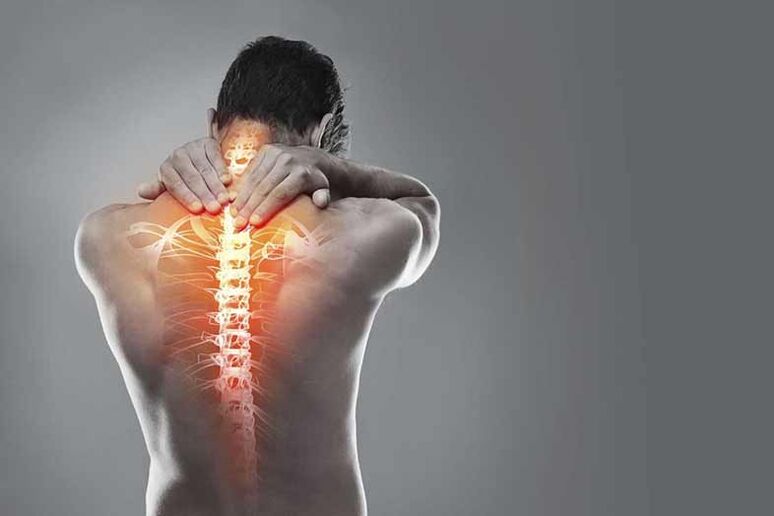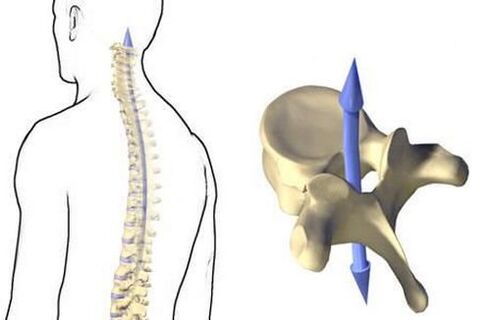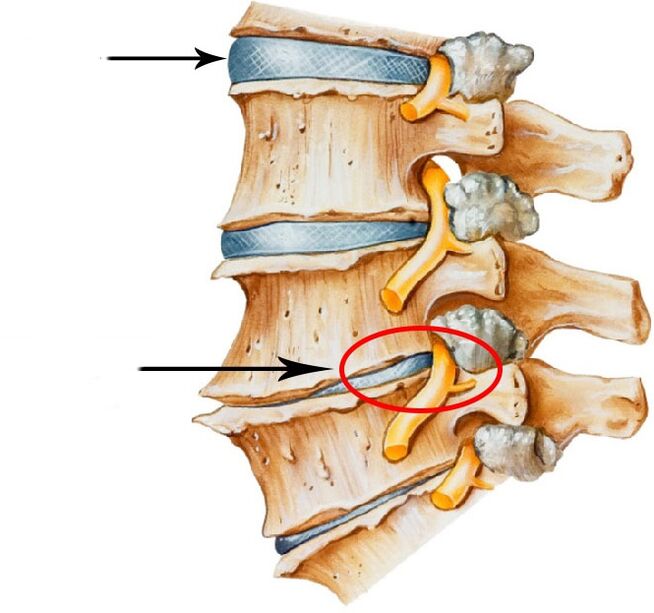
According to statistics, almost half of people aged 30 to 55 have osteochondrosis.The lower age threshold for the disease has been reduced to 18 years in recent years.
What is a bone spur
Osteochondral disease of the spineIt is expressed as the failure of the intervertebral disc, which loses elasticity, elasticity, cracks.
Neck bone and chondropathyIt is related to damage to the intervertebral disc in the cervical spine.
How the spine works
If the essence is better understood, the device of the spine can be described as follows.
The spine consists of the form of a vertebrae located above the other, similar to each other.
Despite the different forms, there is a common structure in the structure of all vertebrae.Each vertebrae has a hole - all holes are also located in the other hole and form a vertical channel (tunnel) through the entire spine.
In this spinal canal, the spinal cord passes through.It passes vertically through the foramen of each vertebrae, its roots (branches, where sensitive nerve ends) leave behind a canal between each pair of vertebrae.This is possible because the vertebrae are not lost to each other, nor are they tightly fixed, and there is a cartilage between each pair of vertebrae - a vertebrae disc.

The wheels join the vertebrae together with the ligaments and act as a shock absorber.Due to their elastic structure, they are elastically compressed during the movement and inclination of the body (from the side of the inclination) or not fixed (when straightened).Therefore, the intervertebral disc is the spine that is flexible and softens the vertical pressure of the spine column from top to bottom to each vertebrae and the load of the vertical vibration that occurs when walking or running.After all, a person is a unique and direct creature.
If the entire load is properly allocated, ensure such work of the spine.Nature creates incredibly stable, cold-resistant and flexible at the same time.
If not?
If the shape of the spine conceived for some reason is violated (bend, excessive bending of the lower back, scoliosis, flat feet) or a continuous sitting position, lying, standing, standing, the disc compound begins to wear out, loses elasticity, loses elasticity, is able to perform vibrational functions, is easy to resist, is susceptible to resist, is susceptible to flattening, rupture, fall off, and fall off and fall off.They stretch toward both sides to form a hernia.
Wear of intervertebral discs - also have a person's upright.After all, only in humans, the spine has a vertical load.This vertical squeeze in life throughout all components of the spine (especially for overweight people), causing the blood supply to gradually worsen to the disc (squeezing the blood vessel direction) - the disk loses its endurance and strength.
What's next?

Press the intervertebral disc herniaBlood vessel,,,,,Nerve rootssometimesspinal cord.
Consequences of cervical bone and chondropathy
Due to changes in spinal anatomical ratio, blood vessels (main arteries and veins) are squeezed.
what happened:Due to changes in spinal anatomical ratio, blood vessels (main arteries and veins) are squeezed.What causes:
- Violation of blood flowing into the brain and violation of all the brain's nutrition.
- Violation of venous outflow and accumulation of toxic substances in brain tissue.
How it manifests:
- Dizziness (until short-term loss of consciousness).
- Headache.
- Visual impairment.Violate smell, taste.
- Bulb disease is associated with difficulty in swallowing, pronunciation, invasion of general and speech and breathing.
- Cognitive impairment: impaired memory, perception, complexity, concentration, and the complexity of logical thinking.Violation of reading.
- Lack - Mind.Inappropriate.Reduce confusion.forgetful.
- There are difficulties in engraving complex and long words, complex grammatical structures.
- Decreased performance and overwork.
- Invasion of emotional and personal domains: keen and unreasonable mood swings, emotional urinary incontinence, irritability, anger.
Diagnosis:Cognitive impairment, aphasia, bulb centroid thriria, circuit breaking encephalopathy, vertebrae-Baslar (VBN), etc. can be diagnosed. Drug therapy performed in these cases:
- Vascular drugs.Their evidence base is extremely low.They need to use a doctor and under the control of their doctors, which can cause a large number of different complications and side effects.
- Noi medicine.Requirements are strictly used for appointments and under the control of a doctor.Many people suffer from quite serious contraindications from the cardiovascular system (with hidden cardiac pathology that can lead to serious negative consequences).Most Lu types do not have positive pharmacological results, that is, this is useless.
- Drugs with sedative effects include sedatives, antidepressants, barbiturates, bromides.Psychotropic drugs.Requirements are strictly used for appointments and under the control of a doctor.They can be addictive and have multiple side effects (dizziness, headache, visual impairment and urination, dry mouth, nausea, etc. Shameful illness, reduced libido, sleep disorders, a group of weight).
Nerve root squeeze (compression) - nerves from the spinal cord to the upper body organs and tissues.
what happened:
Nerve root squeeze (compression) - nerves from the spinal cord to the upper body organs and tissues.
What causes:A significant pain syndrome occurs, usually chronic and frequent.
How it manifests:
- Neck pain, back of the head (turning or still, shooting or chronic).
- Headache (A headache of tension is associated with tension in the back surface of the neck and the muscles on the head - pain - poured over the entire head, usually accompanied by noise and ears, flies in front of the eyes).
- Pain in the upper chest.
- Simulates pain in heart and lungs.
- Pain on the shoulders, shoulders.
- Pain in the shoulder joint or entire hand.
- Fingers, hands, hands are completely numb.
Drug therapy performed in these cases:
- Nonsteroidal anti-inflammatory drugs (pain-allergic drugs, anti-dyes), require strict appointment and control of doctors and in the gastrointestinal tract (gastritis, ulcers, ulcers, ulcerative bleeding), cardiovascular system, cardiovascular system, kidney, kidney, kidney.
- Preparations for relieving muscle hypertonicity need to be used strictly for their intended purposes and used under the control of a doctor, and negatively react in the form of a strong dizziness, weak to complete exhaustion.
The use of drug therapy is the most common practice in the treatment of osteochondrosis.However, this is a symptomatic treatment.Drugs are used to stop the inflammatory process and pain (sometimes you have to resort to Novicaine lockdown), which reduces neurological and psychologically emotional symptoms.Most importantly, pharmacological treatment occurs under the strict supervision of a doctor.
However, if you do not stop the process of violating the ship directly, do not restore the balance of the spine and all related structures (violating the symmetry of the body, flat feet, muscle spasms, muscle spasms as compensatory responses to balance), this disease will not be performed anywhere and will not be helpful and should not be helpful and should be operated in some way.
Osteochondrosis is designed to eliminate the causes of osteochondrosis mentioned above, and nowadays, osteochondrosis is the most effective.
Osteopathy for bone surgery
Rule 1 "early, better" situations, which are especially effective in the case of osteochondrosis!After all, curing osteochondrosis - means not extinguishing pain or other syndromes, but rather restoring the normal position of the spine so that even before the degeneration of the cartilage tissue, the loss of disc on the disc (to restore normal blood supply) will become irreversible.
Osteoplasia determines the location where displacement or deformation occurs.Causes of the ships with spinal vessels.Bone disease treats the body as a single system in which everything connects and affects each other, literally pulling each other.This means that osteopathy restores all structures to work, and changes in the chain lead to the forces that invade the disc.The task of osteopathy is to restore the balance ratio between organs and tissues and eliminate stresses and fixtures that interfere with adequate nutrition.Moreover, if changes in spinal structure require violations of the work of internal organs in the case of neglected disease, osteopathic treatment will aim to eliminate emerging dysfunctions.
That is, osteopathy works together with the root cause of the disease, rather than eliminating its syndrome, including pain.Although he will start working in a state of relief.However, it won't stop.The best approach to osteotherapy is used in combination with physical therapy (to ensure reduced pain and inflammation processes) and physical therapy exercise - exercise therapy (enhances muscle corsets to help the body maintain new unusual but appropriate position).
in conclusion
- The neck cannot be understated.Because the brain should be provided with unhindered nutrition.It depends on the neck being a healthy “commander”.
- You can't wait.The more the disease is emitted, the harder it is to reverse it (sometimes impossible).Osteopathic patients can still be determined to be in a basic state when the disease is still in its base state and will not show in any way.You must never ignore diagnostic tests.
- It is impossible to ignore the prevention of osteocartilage.It's always easier than treating a disease.

























